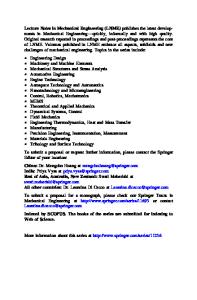Fracture toughness of nanocrystalline metal matrix composites reinforced by aligned carbon nanotubes
- PDF / 589,957 Bytes
- 10 Pages / 584.957 x 782.986 pts Page_size
- 107 Downloads / 378 Views
Jianqiu Zhoua) Department of Mechanical Engineering, Nanjing Tech University, Nanjing, Jiangsu Province 210009, China; and Department of Mechanical Engineering, Wuhan Institute of Technology, Wuhan, Hubei Province 430070, China
David Hui Department of Mechanical Engineering, University of New Orleans, New Orleans, Louisiana 70148, USA
Lu Wang National Technology Research Center on Pressure Vessel and Pipeline Safety Engineering, Hefei General Machinery Research Institute, Hefei, Anhui Province 230031, China (Received 30 March 2015; accepted 9 September 2015)
Experimental observations have shown that carbon nanotubes (CNTs)/Al nanocomposites with high level ordered nanolaminates exhibit greatly improved plasticity. The increased plasticity is mainly attributed to enhanced dislocation storage capability and two-dimensional alignment of the reinforcement. Here a theoretical model is proposed with interactions between aligned CNTs and grain boundary dislocations emitted from a crack tip taken into consideration to investigate crack blunting and fracture toughness in nanocrytalline metal matrix composites (MMCs). The critical shear stress for emission of first dislocation from intersections between a long, flat crack and aligned CNTs is quantitatively characterized. The final equilibrium positions and maximum numbers of emitted dislocations for different orientation angles and microstructures of aligned reinforcement are evaluated. In addition, the dependence of enhanced fracture toughness on effective gliding distance of emitted dislocations is also determined. The results show that the existence of aligned CNTs can lead to an increase of critical crack intensity factor by 77% than that in dislocation free case under certain conditions. The model may provide a basis understanding of ductility in aligned CNTs-reinforced nanocrystalline MMCs on respective of emission and motion of dislocations. I. INTRODUCTION
Nanocrystalline materials generally exhibit superior strength but at the expenses of low tensile ductility and low fracture toughness, which have been considered to be crucial factors limiting their practical utility.1–3 In particular, compared with conventional microcrystalline materials, low fracture toughness of nanocrystalline solids is highly undesired for structural applications, and thus toughening of nanocrystalline metals is emerging.4–7 Hence, much research has been undertaken in understanding the fundamental laws governing the process of crack growth, as well as ductility and strength behaviors in nanocrystalline materials.8–12 In nanocrystalline or ultrafine-grained materials, dislocations emitted from a crack tip glide along one slip plane, stop at opposite grain boundaries (GBs) and eventually
Contributing Editor: Yang-T. Cheng a) Address all correspondence to this author. e-mail: [email protected] DOI: 10.1557/jmr.2015.294 J. Mater. Res., Vol. 30, No. 21, Nov 13, 2015
suppress the emission of subsequent dislocations, which is the most typical process for blunting of the crack.13 Therefore, emissi
Data Loading...











